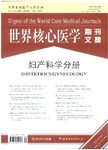宫颈癌放疗后复发用FDG-PET检测——肿瘤的容积和FDG摄取值
FDG-PET in the detection of recurrence of uterine cervical carcinoma following radiation therapy-tumor volume and FDG uptake value作者机构:Department of Radiation Oncology Gunma University Graduate School of Medicine 3- 39- 22 Showa- machi Maebashi Gunma 371- 8511 Japan
出 版 物:《世界核心医学期刊文摘(妇产科学分册)》 (Core Journal in Obstetrics/Gynecology)
年 卷 期:2006年第2卷第6期
页 面:50-51页
学科分类:1002[医学-临床医学] 100214[医学-肿瘤学] 10[医学]
主 题:FDG-PET 血清肿瘤标志物 标准摄取值 疾病复发 放疗 宫颈癌 正电子发射断层成像 异常病变 容积 检测
摘 要:Purpose. We evaluated the use of positron emission tomography (PET) with fluorine- 18- labeled fluoro- 2- deoxy- d- glucose (FDG) in follow- up study after radiation therapy in patients with uterine cervical carcinoma. Materials and methods. Thirty- two studies in 25 patients were reviewed. Twenty patients were treated with external beam irradiation and intracavitary brachytherapy, and five with irradiation following initial surgery. Time frominitial treatment to FDG- PET was 23.3 (5.2- 88.0) months. Rationale for FDG- PET was the presence of symptoms in 6 patients, abnormal serum tumor marker values in 13, abnormal lesions on other diagnostic imaging modalities in 19, and patient request in 2. On visualization of a lesion, the maximum standardized uptake value (maxSUV) of the lesion was calculated, and values over 2.0 were classified as FDG- positive. Maximum tumor diameter and tumor volume in the corresponding disease were estimated by computed tomography (CT) or magnetic resonance imaging (MRI). Results. Sensitivity and specificity of FDG- PET in the detection of recurrent disease were 91.5% (43/47) and 57.1% (4/7), respectively. Four false negative findings were seen for small lung metastases having a volume less than 1 cm3. Three false- positive cases were a localized pneumonitis, a benign pubic bone fracture,and a fibrosis after interstitial brachytherapy. Sensitivity for extrapelvic lymph node metastases was extremely high (100% ); in contrast, sensitivity and specificity for lung and bone lesions were 75.0% (12/16) and 33.3% (1/3), respectively. Regarding tumor volume measurement, good correlation between maxSUV on FDG- PET and tumor volume was obtained (lung metastases, P = 0.03; extrapelvic nodes, P 0.0001). Within this study, all corresponding lesions over 1 cm3 showed a maxSUV value greater than 2.0. Conclusion. FDG- PET is a useful tool for the detection of extrapelvic lesions during the follow- up period after radiation therapy for cervical cancer. T



